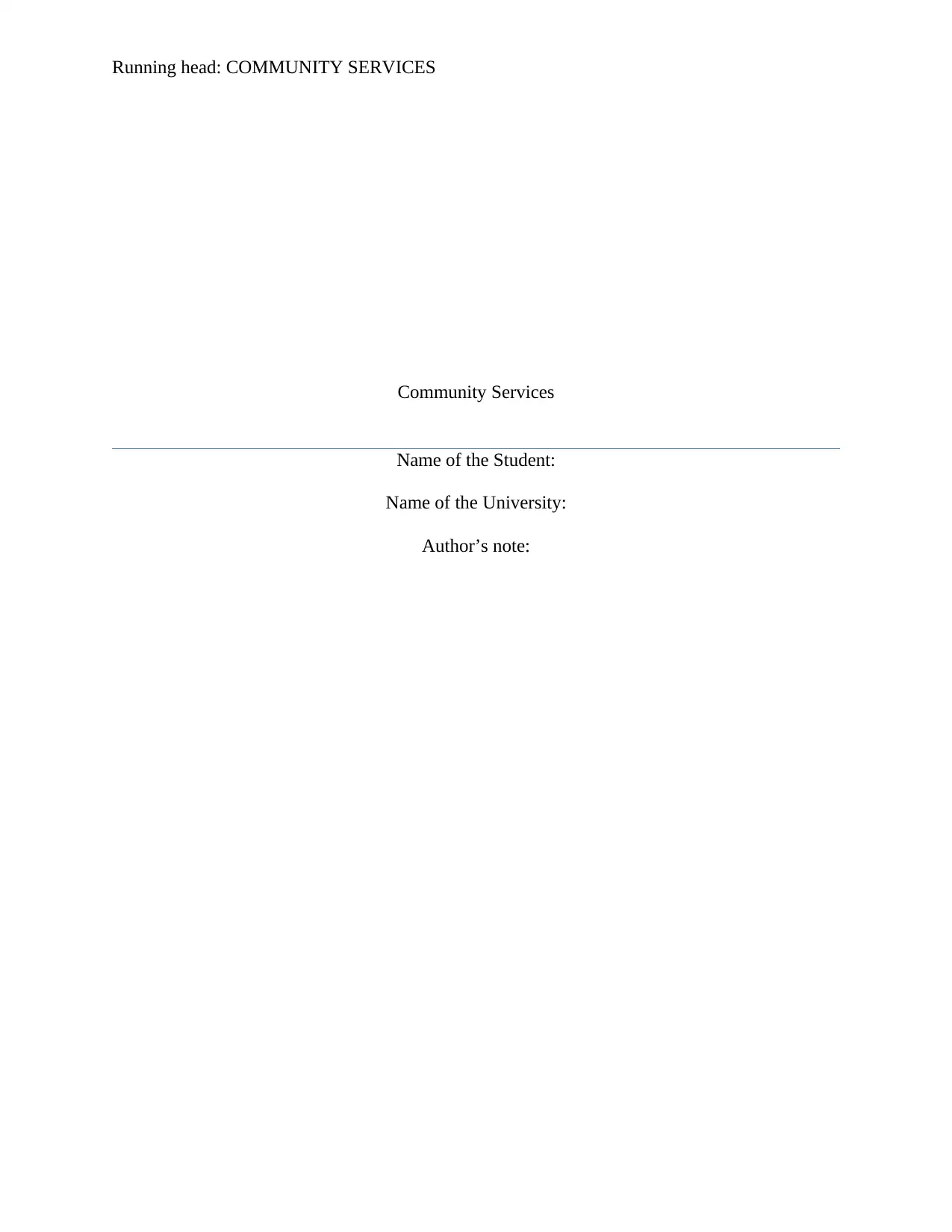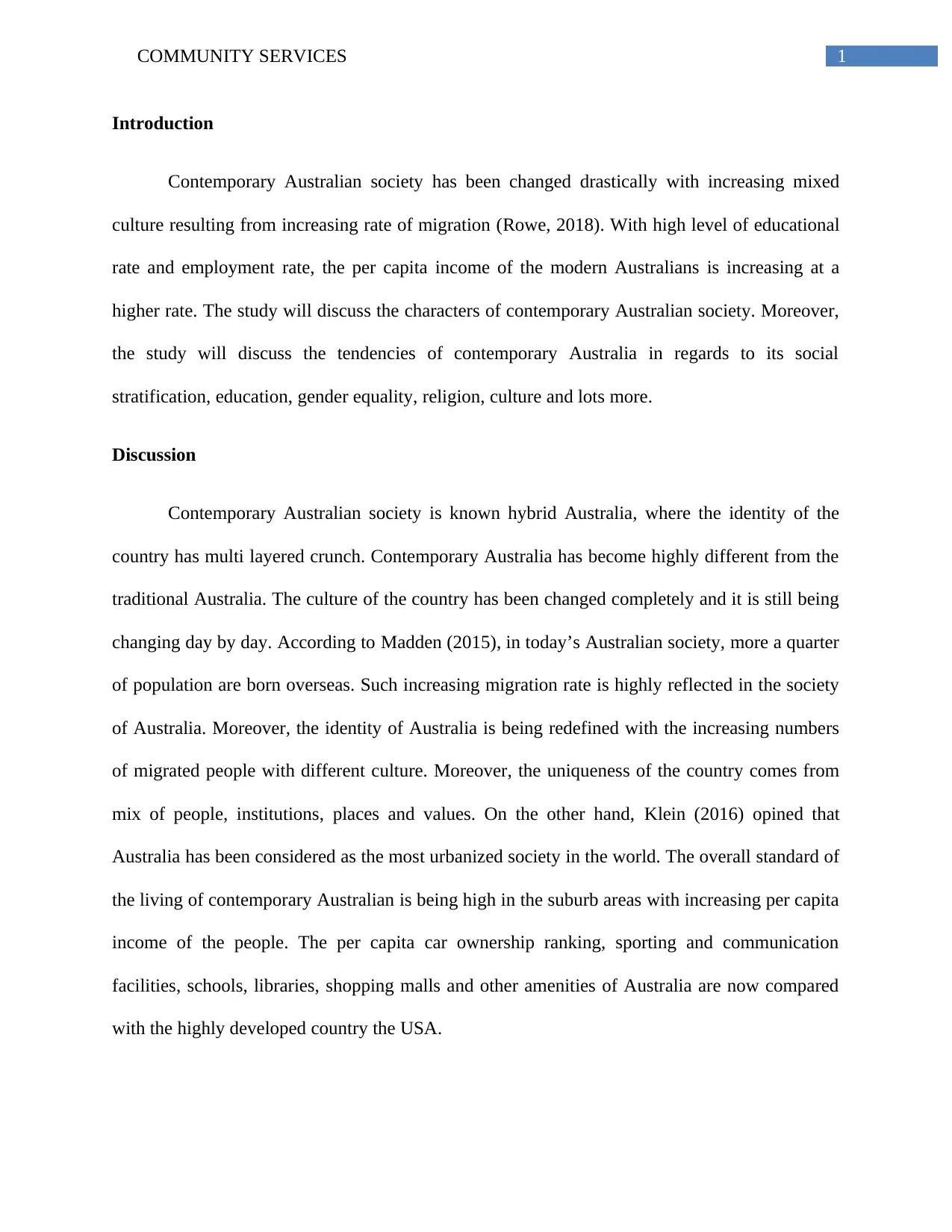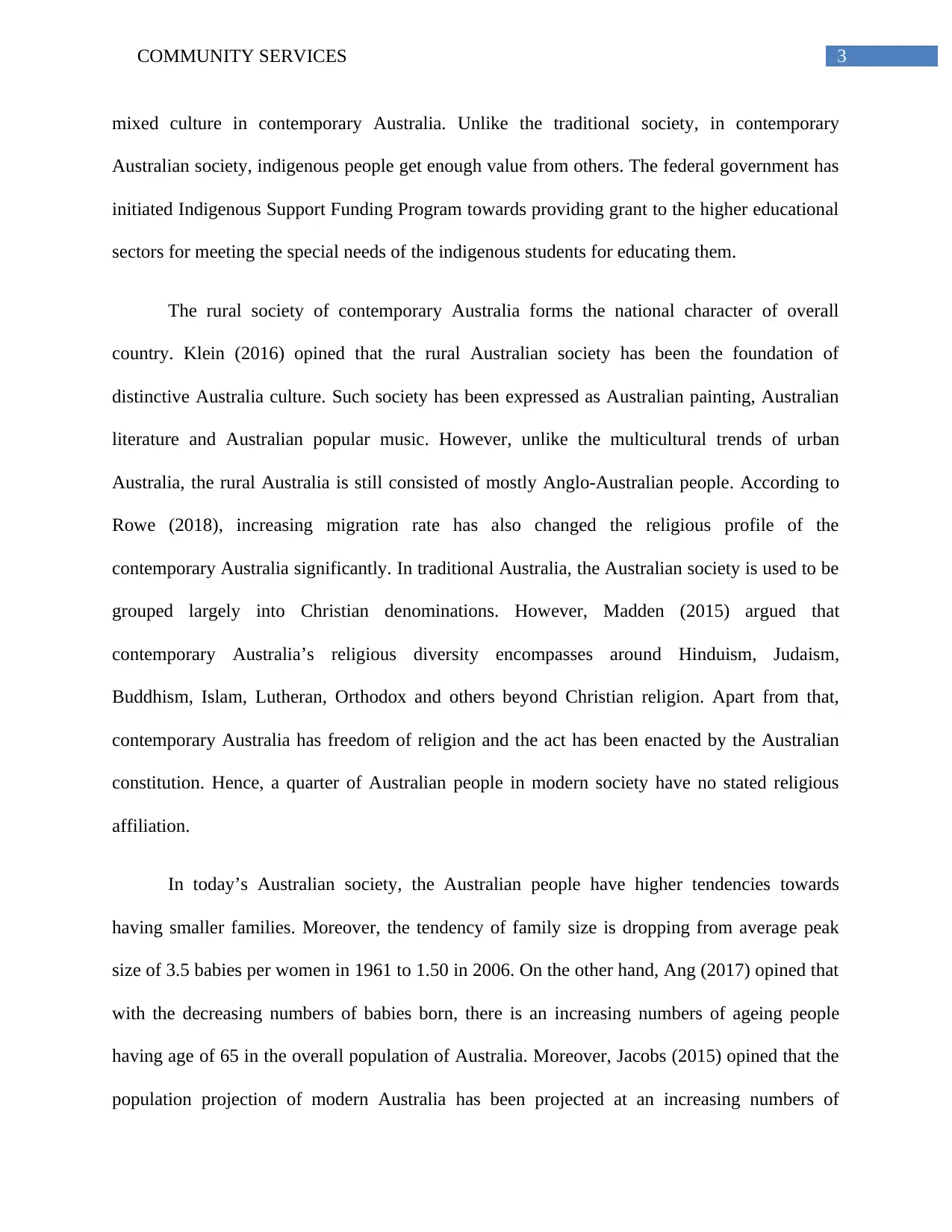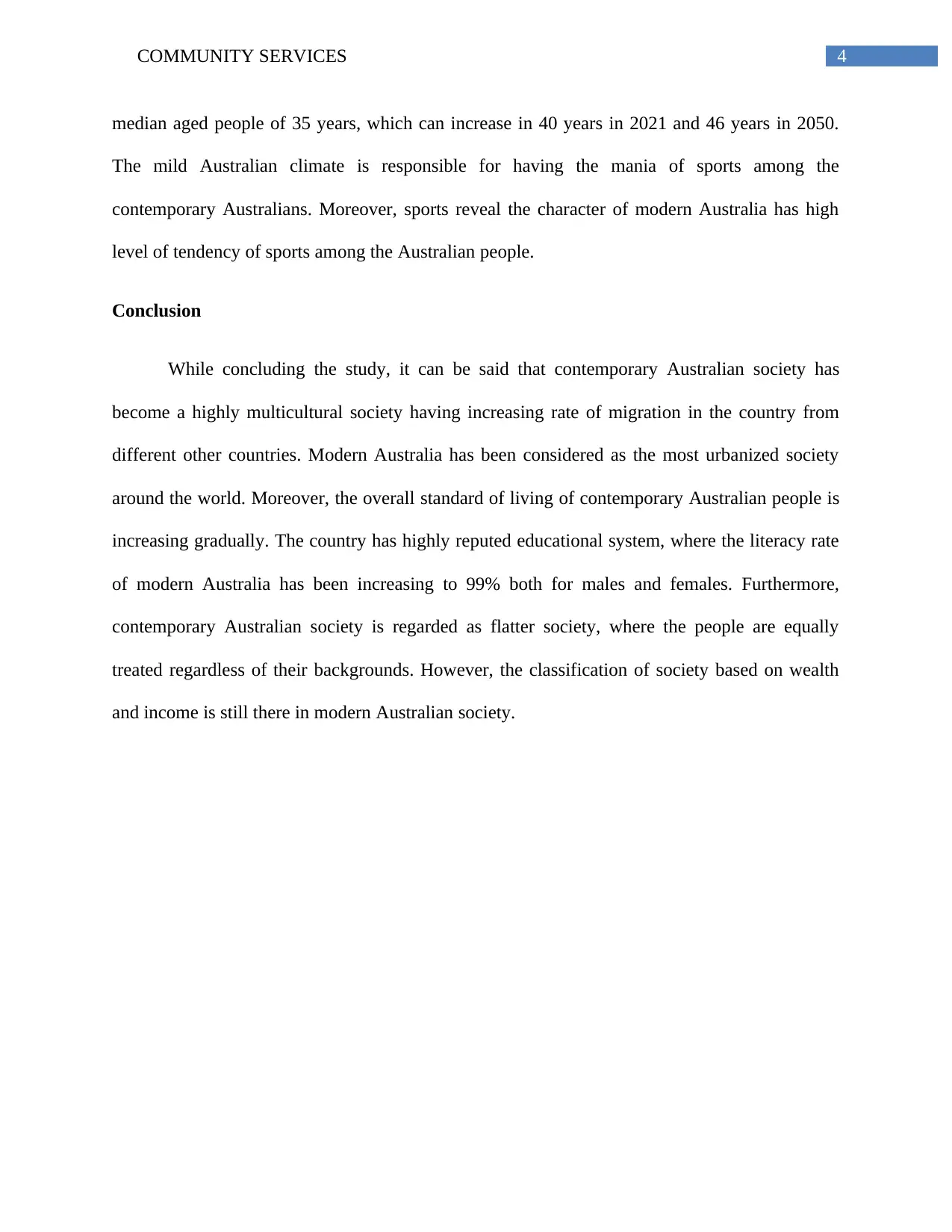Comprehensive Analysis: Contemporary Australian Society and Trends
VerifiedAdded on 2023/06/10
|6
|1457
|447
Essay
AI Summary
This essay provides a comprehensive analysis of contemporary Australian society, examining its key characteristics and trends. The study explores the impact of increasing migration rates on Australia's multicultural identity, highlighting the shift from traditional to hybrid cultural forms. It delves into the country's social stratification, education system, and gender equality, noting the high literacy rates and the evolving treatment of diverse racial and cultural backgrounds. The analysis also covers the changing religious landscape, the trend towards smaller families, and the enduring significance of sports in Australian culture. The essay references several academic sources to support its claims, offering a detailed overview of the evolving dynamics within contemporary Australian society and its place in the world.

Running head: COMMUNITY SERVICES
Community Services
Name of the Student:
Name of the University:
Author’s note:
Community Services
Name of the Student:
Name of the University:
Author’s note:
Paraphrase This Document
Need a fresh take? Get an instant paraphrase of this document with our AI Paraphraser

1COMMUNITY SERVICES
Introduction
Contemporary Australian society has been changed drastically with increasing mixed
culture resulting from increasing rate of migration (Rowe, 2018). With high level of educational
rate and employment rate, the per capita income of the modern Australians is increasing at a
higher rate. The study will discuss the characters of contemporary Australian society. Moreover,
the study will discuss the tendencies of contemporary Australia in regards to its social
stratification, education, gender equality, religion, culture and lots more.
Discussion
Contemporary Australian society is known hybrid Australia, where the identity of the
country has multi layered crunch. Contemporary Australia has become highly different from the
traditional Australia. The culture of the country has been changed completely and it is still being
changing day by day. According to Madden (2015), in today’s Australian society, more a quarter
of population are born overseas. Such increasing migration rate is highly reflected in the society
of Australia. Moreover, the identity of Australia is being redefined with the increasing numbers
of migrated people with different culture. Moreover, the uniqueness of the country comes from
mix of people, institutions, places and values. On the other hand, Klein (2016) opined that
Australia has been considered as the most urbanized society in the world. The overall standard of
the living of contemporary Australian is being high in the suburb areas with increasing per capita
income of the people. The per capita car ownership ranking, sporting and communication
facilities, schools, libraries, shopping malls and other amenities of Australia are now compared
with the highly developed country the USA.
Introduction
Contemporary Australian society has been changed drastically with increasing mixed
culture resulting from increasing rate of migration (Rowe, 2018). With high level of educational
rate and employment rate, the per capita income of the modern Australians is increasing at a
higher rate. The study will discuss the characters of contemporary Australian society. Moreover,
the study will discuss the tendencies of contemporary Australia in regards to its social
stratification, education, gender equality, religion, culture and lots more.
Discussion
Contemporary Australian society is known hybrid Australia, where the identity of the
country has multi layered crunch. Contemporary Australia has become highly different from the
traditional Australia. The culture of the country has been changed completely and it is still being
changing day by day. According to Madden (2015), in today’s Australian society, more a quarter
of population are born overseas. Such increasing migration rate is highly reflected in the society
of Australia. Moreover, the identity of Australia is being redefined with the increasing numbers
of migrated people with different culture. Moreover, the uniqueness of the country comes from
mix of people, institutions, places and values. On the other hand, Klein (2016) opined that
Australia has been considered as the most urbanized society in the world. The overall standard of
the living of contemporary Australian is being high in the suburb areas with increasing per capita
income of the people. The per capita car ownership ranking, sporting and communication
facilities, schools, libraries, shopping malls and other amenities of Australia are now compared
with the highly developed country the USA.

2COMMUNITY SERVICES
Australia is highly popular as clever country having education as its leading export
industry. Moreover, the university education is increasingly being globalized and burgeoning day
by day. Contemporary Australia has a highly reputed educational system having regulated
qualifications across vocational education, schools and higher education. Such high quality
education is highly reflected in contemporary Australian society. The literacy rate in Australia is
at 99% both for males and females. Hence, it is evident that educational system in this society is
available equally both for male and female persons. According to Jacobs, (2015), most of people
in contemporary Australia society are highly affluent than several generation ago. Moreover,
today’s Australia is much more identified as flat society, where all the people are equally treated
regardless of their backgrounds. However, Dudgeon and Walker (2015) argued that distribution
of wealth and income is still unequal in contemporary Australian society. Moreover, Australian
society is generally divided into six classes like precariat, new workers, ageing workers,
established middle, emerging affluent and established affluent. Such divisions are not made
based on just wealth and income, but the society is divided based on working types, generation,
culture, employment and others.
In the previous days, the Australian society was highly divided based on the race, where
racial inequality was high in the country. However, Ang (2017) opined that in contemporary
Australian society while skin privileges are getting scope of taking extra advantages over the
black people. Australia government is working hard to implement the anti-discrimination laws in
the society. Hence, the settled immigrants and the people from different racial and cultural
backgrounds are less likely to face any discrimination and racism in the society. Bodkin-
Andrews and Carlson (2016) pointed out that Australian education highly attracts the
international students. Hence, such matter is leading to cultural mix in the society resulting in
Australia is highly popular as clever country having education as its leading export
industry. Moreover, the university education is increasingly being globalized and burgeoning day
by day. Contemporary Australia has a highly reputed educational system having regulated
qualifications across vocational education, schools and higher education. Such high quality
education is highly reflected in contemporary Australian society. The literacy rate in Australia is
at 99% both for males and females. Hence, it is evident that educational system in this society is
available equally both for male and female persons. According to Jacobs, (2015), most of people
in contemporary Australia society are highly affluent than several generation ago. Moreover,
today’s Australia is much more identified as flat society, where all the people are equally treated
regardless of their backgrounds. However, Dudgeon and Walker (2015) argued that distribution
of wealth and income is still unequal in contemporary Australian society. Moreover, Australian
society is generally divided into six classes like precariat, new workers, ageing workers,
established middle, emerging affluent and established affluent. Such divisions are not made
based on just wealth and income, but the society is divided based on working types, generation,
culture, employment and others.
In the previous days, the Australian society was highly divided based on the race, where
racial inequality was high in the country. However, Ang (2017) opined that in contemporary
Australian society while skin privileges are getting scope of taking extra advantages over the
black people. Australia government is working hard to implement the anti-discrimination laws in
the society. Hence, the settled immigrants and the people from different racial and cultural
backgrounds are less likely to face any discrimination and racism in the society. Bodkin-
Andrews and Carlson (2016) pointed out that Australian education highly attracts the
international students. Hence, such matter is leading to cultural mix in the society resulting in
⊘ This is a preview!⊘
Do you want full access?
Subscribe today to unlock all pages.

Trusted by 1+ million students worldwide

3COMMUNITY SERVICES
mixed culture in contemporary Australia. Unlike the traditional society, in contemporary
Australian society, indigenous people get enough value from others. The federal government has
initiated Indigenous Support Funding Program towards providing grant to the higher educational
sectors for meeting the special needs of the indigenous students for educating them.
The rural society of contemporary Australia forms the national character of overall
country. Klein (2016) opined that the rural Australian society has been the foundation of
distinctive Australia culture. Such society has been expressed as Australian painting, Australian
literature and Australian popular music. However, unlike the multicultural trends of urban
Australia, the rural Australia is still consisted of mostly Anglo-Australian people. According to
Rowe (2018), increasing migration rate has also changed the religious profile of the
contemporary Australia significantly. In traditional Australia, the Australian society is used to be
grouped largely into Christian denominations. However, Madden (2015) argued that
contemporary Australia’s religious diversity encompasses around Hinduism, Judaism,
Buddhism, Islam, Lutheran, Orthodox and others beyond Christian religion. Apart from that,
contemporary Australia has freedom of religion and the act has been enacted by the Australian
constitution. Hence, a quarter of Australian people in modern society have no stated religious
affiliation.
In today’s Australian society, the Australian people have higher tendencies towards
having smaller families. Moreover, the tendency of family size is dropping from average peak
size of 3.5 babies per women in 1961 to 1.50 in 2006. On the other hand, Ang (2017) opined that
with the decreasing numbers of babies born, there is an increasing numbers of ageing people
having age of 65 in the overall population of Australia. Moreover, Jacobs (2015) opined that the
population projection of modern Australia has been projected at an increasing numbers of
mixed culture in contemporary Australia. Unlike the traditional society, in contemporary
Australian society, indigenous people get enough value from others. The federal government has
initiated Indigenous Support Funding Program towards providing grant to the higher educational
sectors for meeting the special needs of the indigenous students for educating them.
The rural society of contemporary Australia forms the national character of overall
country. Klein (2016) opined that the rural Australian society has been the foundation of
distinctive Australia culture. Such society has been expressed as Australian painting, Australian
literature and Australian popular music. However, unlike the multicultural trends of urban
Australia, the rural Australia is still consisted of mostly Anglo-Australian people. According to
Rowe (2018), increasing migration rate has also changed the religious profile of the
contemporary Australia significantly. In traditional Australia, the Australian society is used to be
grouped largely into Christian denominations. However, Madden (2015) argued that
contemporary Australia’s religious diversity encompasses around Hinduism, Judaism,
Buddhism, Islam, Lutheran, Orthodox and others beyond Christian religion. Apart from that,
contemporary Australia has freedom of religion and the act has been enacted by the Australian
constitution. Hence, a quarter of Australian people in modern society have no stated religious
affiliation.
In today’s Australian society, the Australian people have higher tendencies towards
having smaller families. Moreover, the tendency of family size is dropping from average peak
size of 3.5 babies per women in 1961 to 1.50 in 2006. On the other hand, Ang (2017) opined that
with the decreasing numbers of babies born, there is an increasing numbers of ageing people
having age of 65 in the overall population of Australia. Moreover, Jacobs (2015) opined that the
population projection of modern Australia has been projected at an increasing numbers of
Paraphrase This Document
Need a fresh take? Get an instant paraphrase of this document with our AI Paraphraser

4COMMUNITY SERVICES
median aged people of 35 years, which can increase in 40 years in 2021 and 46 years in 2050.
The mild Australian climate is responsible for having the mania of sports among the
contemporary Australians. Moreover, sports reveal the character of modern Australia has high
level of tendency of sports among the Australian people.
Conclusion
While concluding the study, it can be said that contemporary Australian society has
become a highly multicultural society having increasing rate of migration in the country from
different other countries. Modern Australia has been considered as the most urbanized society
around the world. Moreover, the overall standard of living of contemporary Australian people is
increasing gradually. The country has highly reputed educational system, where the literacy rate
of modern Australia has been increasing to 99% both for males and females. Furthermore,
contemporary Australian society is regarded as flatter society, where the people are equally
treated regardless of their backgrounds. However, the classification of society based on wealth
and income is still there in modern Australian society.
median aged people of 35 years, which can increase in 40 years in 2021 and 46 years in 2050.
The mild Australian climate is responsible for having the mania of sports among the
contemporary Australians. Moreover, sports reveal the character of modern Australia has high
level of tendency of sports among the Australian people.
Conclusion
While concluding the study, it can be said that contemporary Australian society has
become a highly multicultural society having increasing rate of migration in the country from
different other countries. Modern Australia has been considered as the most urbanized society
around the world. Moreover, the overall standard of living of contemporary Australian people is
increasing gradually. The country has highly reputed educational system, where the literacy rate
of modern Australia has been increasing to 99% both for males and females. Furthermore,
contemporary Australian society is regarded as flatter society, where the people are equally
treated regardless of their backgrounds. However, the classification of society based on wealth
and income is still there in modern Australian society.

5COMMUNITY SERVICES
References
Ang, I. (2017). Claiming Chinatown: Asian Australians, Public Art and the Making of Urban
Culture. Journal of Australian Studies, 41(3), 336-350.
Bodkin-Andrews, G., & Carlson, B. (2016). The legacy of racism and Indigenous Australian
identity within education. Race Ethnicity and Education, 19(4), 784-807.
Dudgeon, P., & Walker, R. (2015). Decolonising Australian psychology: Discourses, strategies,
and practice. Journal of Social and Political Psychology, 3(1), 276-297.
Jacobs, K. (2015). ‘Hurtling down the track’: The significance of Australian population debates
in an era of anxiety. Journal of Sociology, 51(4), 799-811.
Klein, M. (2016). Managing diversity: is Australia bucking the postmulticulturalist trend or on its
way to embrace interculturalism?. Australian & New Zealand Journal of European
Studies, 8(2).
Madden, C. (2015). The place and perspective of war veterans in contemporary Australian
democracy. Meanjin, 74(3), 214.
Rowe, D. (2018). Cultural citizenship, media and sport in contemporary Australia. International
Review for the Sociology of Sport, 53(1), 11-29.
References
Ang, I. (2017). Claiming Chinatown: Asian Australians, Public Art and the Making of Urban
Culture. Journal of Australian Studies, 41(3), 336-350.
Bodkin-Andrews, G., & Carlson, B. (2016). The legacy of racism and Indigenous Australian
identity within education. Race Ethnicity and Education, 19(4), 784-807.
Dudgeon, P., & Walker, R. (2015). Decolonising Australian psychology: Discourses, strategies,
and practice. Journal of Social and Political Psychology, 3(1), 276-297.
Jacobs, K. (2015). ‘Hurtling down the track’: The significance of Australian population debates
in an era of anxiety. Journal of Sociology, 51(4), 799-811.
Klein, M. (2016). Managing diversity: is Australia bucking the postmulticulturalist trend or on its
way to embrace interculturalism?. Australian & New Zealand Journal of European
Studies, 8(2).
Madden, C. (2015). The place and perspective of war veterans in contemporary Australian
democracy. Meanjin, 74(3), 214.
Rowe, D. (2018). Cultural citizenship, media and sport in contemporary Australia. International
Review for the Sociology of Sport, 53(1), 11-29.
⊘ This is a preview!⊘
Do you want full access?
Subscribe today to unlock all pages.

Trusted by 1+ million students worldwide
1 out of 6
Related Documents
Your All-in-One AI-Powered Toolkit for Academic Success.
+13062052269
info@desklib.com
Available 24*7 on WhatsApp / Email
![[object Object]](/_next/static/media/star-bottom.7253800d.svg)
Unlock your academic potential
Copyright © 2020–2025 A2Z Services. All Rights Reserved. Developed and managed by ZUCOL.





